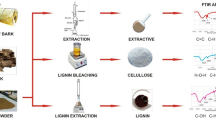Abstract
Twenty-one plant leaf materials were screened for benzene adsorption efficiency in the static system, and the leaf material from Dieffenbachia picta, Acrostichum aureum, Ficus religiosa, Lagerstroemia macrocarpa, Alstonia scholaris, and Dracaena sanderiana were found to have high potential for benzene removal. The relation between quantity and composition of wax to benzene removal efficiency was studied. Although high quantities of wax occurred in some leaf materials, low benzene removal was clearly found if compared with other plant materials with the same wax quantity. Alpha-linoleic acid and dodecyl cyclohexane were found to be the main composition in plant leaf materials with high benzene adsorption, and it might be a key factor for benzene removal.







Similar content being viewed by others
References
Beck, K. R., & Lynn, G. M. (1997). Extraction of cotton impurities: supercritical C02 vs. SoxhIeVTCE. Textile Chemist and Colorist, 29(8), 88–70.
Binnie, J., Cape, J. N., Mackie, N., & Leith, I. D. (2002). Exchange of organic solvents between the atmosphere and grass-the use of open top chambers. Science of the Total Environment, 285, 53–67.
Collins, C. D., Bell, J. N. B., & Crews, C. (2000). Benzene accumulation in horticultural crops. Chemosphere, 40, 109–114.
Environmental Agency. (2009). Soil guideline values for ethylbenzene in soil. Bristol: Environment Agency.
Gorna-Binkul, A., Keymeulen, R., Van, L. H., & Buszewski, B. (1996). Determination of monocyclic aromatic hydrocarbons in fruit and vegetables by gas chromatography–mass spectrometry. Journal of Chromatography A, 734, 297–302.
Guieysse, B., Hort, C., Platel, V., Munoz, R., Ondarts, M., & Revah, S. (2008). Biological treatment of indoor air for VOC removal: potential and challenges. Biotechnology Advances, 26, 398–410.
Hoerr, C. W., & Balston, A. W. (1994). The solubilities of the normal saturated fatty acids II. Journal of Organic Chemistry, 9(4), 329–337.
Jansen, E. F., & Olson, A. C. (1969). Metabolism of carbon-14-labeled benzene and toluene in avocado fruit. Plant Physiology, 44, 786–787.
Kamath, R., Rentz, J. A., Schnoor, J. L., & Alvarez, P. J. J. (2004). Phytoremediation of hydrocarbon-contaminated soils: Principles and applications. In R. Vazquez-Duhalt & R. Quintero-Ramirez (Eds.), Studies in surface science and catalysis (pp. 447–478). Amsterdam: Elsevier.
Kylin, H., Grimvall, E., & Ostman, C. (1994). Environmental monitoring of polychlorinated biphenyls using pine needles as passive samples. Environmental Science and Technology, 28, 1320–1324.
Liu, Y., Mub, Y., Zhub, Y., Dinga, H., & Arens, N. (2007). Which ornamental plant species effectively remove benzene from indoor air? Atmospheric Environment, 41, 650–654.
Orwell, R. L., Wood, R., Tarran, J., Torpy, F., & Burchett, M. (2004). Removal of benzene by the indoor plants/substrate microcosm and implications for air quality. Sydney: Plants and Environmental Quality Group, Faculty of Science, University of Technology.
Poborski, P. (1988). Pollutant penetration through the cuticle. In S. Schulte-Hostede et al. (Eds.), Air pollution and plant metabolism (pp. 19–35). London: Elsevier.
Pollution Control Department. (2007). Development of environmental and emission standards of volatile organic compounds (VOCs) in Thailand. Bangkok, Thailand.
Riederer, M. (1990). Estimating partitioning and transport of organic chemicals in the foliage atmosphere system-discussion of a fugacity-based model. Environmental Science and Technology, 24, 829–937.
Schnatter, A. R., Rosamili, K., & Nancy, C. W. (2005). Review of the literature on benzene exposure and leukemia subtypes. Chemico-Biological Interactions, 153–154, 9–21.
Slaski, J. J., Archambault, D. J., & Li, X. (2000). The potential use of PAH accumulation as a marker of exposure to air emission from oil and gas flares. Edmonton: Air Research Users Group, Alberta Environment.
Topp, E., Scheunert, I., Attar, A., & Korte, F. (1986). Factors affecting the uptake of C-14-labelled organic chemicals by plants from soil. Ecotoxicology and Environmental Safety, 11, 219–228.
Treesubsuntorn, C., & Thiravetyan, P. (2012). Removal of benzene from indoor air by Dracaena sanderiana: effect of wax and stomata. Atmospheric Environment, 57, 317–321.
Tsiros, I. X., Ambrose, R. B., & Chronopoulou-sereli, A. (1999). Air vegetation- soil partition of toxic chemicals in environmental simulation modeling. GLOBAL NEST: the International Journal, 1(3), 177–184.
Ugrekhelidze, D., Korte, F., & Kvesitadz, G. (1996). Uptake and transformation of benzene and toluene by plant leaves. Ecotoxicology and Environmental Safety, 37, 24–29.
Wolverton, B. C. (1996). How to grow fresh air. New York: Penguin Book.
Wolverton, B. C., Johnson, A., Bounds, K. (1989). Interior landscape plants for indoor air pollution abatement. Final report. NASA Stennis Space Centre MS, USA.
World Health Organization. (2000). Air quality guideline for Europe. European Series 91. WHO Regional Publications.
Acknowledgments
The authors would like to thank the Thailand Research Fund and King Mongkut’s University and Technology Thonburi (KMUTT) for their support for this research through the Royal Golden Jubilee Ph.D. Program (Grant No. PHD/0319/2550).
Author information
Authors and Affiliations
Corresponding author
Rights and permissions
About this article
Cite this article
Treesubsuntorn, C., Suksabye, P., Weangjun, S. et al. Benzene Adsorption by Plant Leaf Materials: Effect of Quantity and Composition of Wax. Water Air Soil Pollut 224, 1736 (2013). https://doi.org/10.1007/s11270-013-1736-5
Received:
Accepted:
Published:
DOI: https://doi.org/10.1007/s11270-013-1736-5




